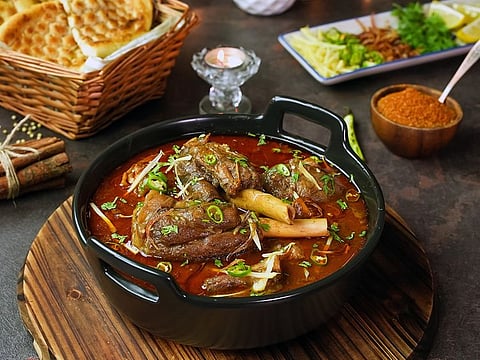Nihari: Fuel for the body - and heart
Spicy stew made of meaty bones is hearty breakfast dish eaten across India and Pakistan

When I was about 13, I was put in charge of doing the thrice-weekly butcher run to get mutton and chicken for our family from the neighbourhood meat stall. The mutton shop owner was in the habit of asking this question straight up when any customer came along: “You want meat or spare parts?”
By ‘spare parts’ he meant brain, liver, lungs, hooves and even meaty bones with marrow in them. And the spare parts we bought the most were the meaty bones - for nihari.
Nihari is the quintessential breakfast of many Muslim families in the subcontinent, especially on weekends. It is also very popular as a suhour dish during Ramadan. It’s a spicy stew made of bones - from either cow, sheep or camel - and cooked with a variety of spices and herbs. While in Pakistan the beef version is preferred, in India, the mutton variety is more prevalent.
When it is made using hooves of cow or sheep, it is called paya-nihari, or simply paya. It’s a hearty dish, rich in protein (which is great) and fat (which isn’t). It is eaten with naan or roti (flatbread) that is dipped in the broth.
On Saturdays, a bowl of nihari was consumed with relish along with two rotis (unleavened bread). And this fuelled us up for an entire morning of non-stop cricket or hockey. It was richer than our usual breakfast of omelette and rotis. Most certainly, it lasted us far longer than the running-late-for-school breakfast of bun and jam, which used to make me feel famished by the time I reached school.

Growing up in Bangalore, India, it was our favoured weekend breakfast dish, and made at home using lamb shanks. On Saturdays, a bowl of nihari was consumed with relish along with two rotis (unleavened bread). And this fuelled us up for an entire morning of non-stop cricket or hockey. It was richer than our usual breakfast of omelette and rotis. Most certainly, it lasted us far longer than the running-late-for-school breakfast of bun and jam, which used to make me feel famished by the time I reached school.
Years have passed, but I have retained my love for nihari. However, I am not 15 anymore, and it is definitely not the type of dish one can have too often, given the generally sedentary lifestyles we lead here. God knows, food consumption is already out of control.
So nihari is now a once-monthly affair. (More frequent during Ramadan, though).
But, on the days there is homemade nihari for breakfast, it is difficult to describe the sense of elation, the satisfaction that takes over. It’s the heartiest of hearty breakfasts, and when followed up with a cup of piping hot tea, ushers in a feeling of general well-being. The feeling that life is treating you well.
Try this classic nihari recipe, slow-cooked with spices and herbs.
Share your food stories with us at food@gulfnews.com
Sign up for the Daily Briefing
Get the latest news and updates straight to your inbox




